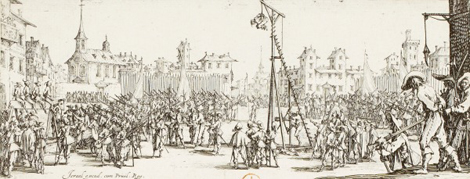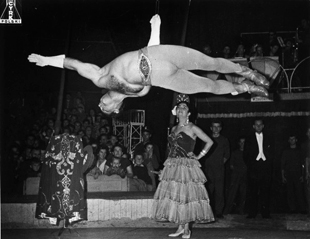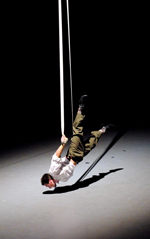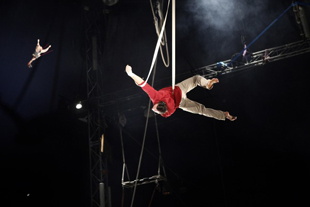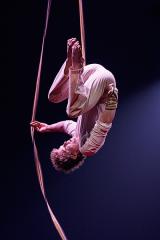Strappado or strap
by Pascal Jacob
It is difficult to precisely date the first use of these two leather straps for sporting and entertainment purposes, if only because, like several other acrobatic disciplines, you need to imagine that it derived from everyday usage. The strap is a transposition of the liana, which gradually transformed into ropes, useful for accessing a platform, a level, a high branch and, more broadly speaking for raising oneself up or covering a certain distance. But straps may also have been inspired by the leather reins used by the mostly Chinese horsemen of the Steppe to guide their mounts. Some equestrian bridles are decorated with little bells to ward off evil spirits, and in some regions of China these little objects are found attached to straps, aimed at creating rhythm for gymnasts at work.
In China, mainly in the 17th century during the Qing dynasty (1644-1912), the use of straps in a performance register was first symbolised by the verticality of a repertory of static figures. The discipline was integrates by acrobatic companies founded from the 1950s onward and was closer to the rings technique before gradually developing towards an autonomous form with the creation of new figures.
Semantically speaking, it is interesting to assimilate the straps to the “Strappado”, an ancient form of torture in use – mainly on boats – in the 15th century that was evoked by the name of a 19th century gymnastic figure, entailing hanging by one's hands from a rope and passing one's body through the two spread out arms. The etymology of the word lies halfway between the Italian strappata, the past participle of the verb strappare, meaning to pull up or tear off, and the gothic strappan, meaning to tie solidly. The English term strap reinforces this analogy, obvious in the case of the "strapper" or "strappist" Lewie West whose final figure in his act seems to be a living demonstration of the estrapade.
Straps
by Magali Sizorn
Aerial straps are a type of acrobatic apparatus made of two linked and suspended natural or synthetic fibre ribbons, the ends of which form a stitched loop through which the performers can pass their wrists and ankles. The links to other strength apparatus are clear: the straps are reminiscent of double cordes lisses (often used by two performers) or rings, with wooden circles that are replaced in some cases by safety loops, straps or flexible rings.
Pushing the boundaries
The earliest aerial strap acts are thought to have originated in China. In his book on aerial acrobatics, Adrian makes special mention of an act performed by the Beijing Circus in France in 1956 in which a number of pieces of vertical apparatus, including aerial straps, allowed for rotating ascents and drops (Adrian, 1988, 16). This exercise would be repeated and, as always in the circus ring, made more complex and spectacular through the development of solo or duo performances, straps linked to other apparatus or combinations of static and energetic routines, to name but a few.
The brothers Valery and Yury Panteleenko brought influences to these acts that borrowed as much from gymnastics as aerial ballets. From the 1970s onwards, on the initiative of acrobatic trainer Vladivien Levshin, they created a duo routine that would go down in circus history.
Their appearance in the closing ceremony of the 1980 Moscow Olympic Games provided them with international visibility, and they became successful in rings worldwide. The initial simplicity of the apparatus, vertical movements, and exercises of strength were complemented by the lightness of their swinging, ascent and circular movements. In addition, their work on lifts was later developed by other duos, both male and female (mainly Wladimir et Olga Kurziamov in the 1990s).
The straps are generally a promise, not so much of flight, but of testing the body, a strapped up body – when that body is raised by wrapping the straps around the arms – one that is tired, with paralyzed muscles. The physical techniques used are very close to those of the rings artists. Moreover the tours de force are identical from gymnasiums to the circus ring, and from the wooden rings to the fabric straps: the iron cross, forward or backward planks, and balance positions…
Circulate
The highlight of the classic act is a rotating plunge where the acrobat falls to within a hair's breadth of the ground. To and fro motions, twists, strongholds or balance positions, and games of exploring this vertical line that links the sky to the earth: movement within the space is mainly vertical and the straps, designating the space, are a measure of this, as seen in the aerial movements of Elod Trager of the BurenCirque, at the centre of an installation by Daniel Buren at the Grand Palais, for Monumenta 2012. Movement can also be horizontal when the ground is exploited in turns, off-balance movements or when the acrobat draws large circles at a greater or lesser height, suspended by the straps above the ground. Kasper Holm, then a student at the Cnac (2011), worked extremely closely to the ground under a structure that included several straps. The games within the space are multiplied whenever the apparatus are redesigned, providing volume, a frame and a structure.
In Le Cri du caméléon, the 1995 Cnac graduation show directed by Joseph Nadj, the audience saw a character rolling and raising himself up, evoking the strongmen in shows from another era, such as Zampano, breaking and untying the chains that he himself has attached. The audience find themselves in universes and among figures created or suggested by the almost anachronistic presence of this exercise.



